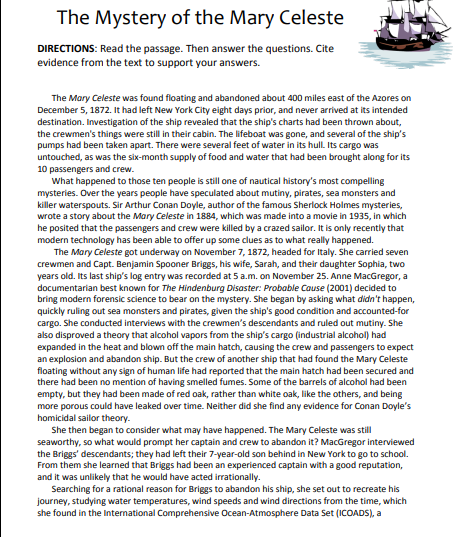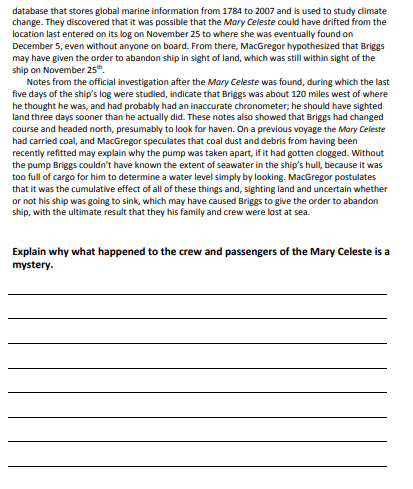Explain why what happened to the crew and passengers of the Mary Celeste is a mystery.
Explain why what happened to the crew and passengers of the Mary Celeste is a mystery.
Related questions
Question

Transcribed Image Text:The Mystery of the Mary Celeste
DIRECTIONS: Read the passage. Then answer the questions. Cite
evidence from the text to support your answers.
The Mary Celeste was found floating and abandoned about 400 miles east of the Azores on
December 5, 1872. It had left New York City eight days prior, and never arrived at its intended
destination. Investigation of the ship revealed that the ship's charts had been thrown about,
the crewmen's things were still in their cabin. The lifeboat was gone, and several of the ship's
pumps had been taken apart. There were several feet of water in its hull. Its cargo was
untouched, as was the six-month supply of food and water that had been brought along for its
10 passengers and crew.
What happened to those ten people is still one of nautical history's most compelling
mysteries. Over the years people have speculated about mutiny, pirates, sea monsters and
killer waterspouts. Sir Arthur Conan Doyle, author of the famous Sherlock Holmes mysteries,
wrote a story about the Mary Celeste in 1884, which was made into a movie in 1935, in which
he posited that the passengers and crew were killed by a crazed sailor. It is only recently that
modern technology has been able to offer up some clues as to what really happened.
The Mary Celeste got underway on November 7, 1872, headed for Italy. She carried seven
crewmen and Capt. Benjamin Spooner Briggs, his wife, Sarah, and their daughter Sophia, two
years old. Its last ship's log entry was recorded at 5 a.m. on November 25. Anne MacGregor, a
documentarian best known for The Hindenburg Disaster: Probable Cause (2001) decided to
bring modern forensic science to bear on the mystery. She began by asking what didn't happen,
quickly ruling out sea monsters and pirates, given the ship's good condition and accounted-for
cargo. She conducted interviews with the crewmen's descendants and ruled out mutiny. She
also disproved a theory that alcohol vapors from the ship's cargo (industrial alcohol) had
expanded in the heat and blown off the main hatch, causing the crew and passengers to expect
an explosion and abandon ship. But the crew of another ship that had found the Mary Celeste
floating without any sign of human life had reported that the main hatch had been secured and
there had been no mention of having smelled fumes. Some of the barrels of alcohol had been
empty, but they had been made of red oak, rather than white oak, like the others, and being
more porous could have leaked over time. Neither did she find any evidence for Conan Doyle's
homicidal sailor theory.
She then began to consider what may have happened. The Mary Celeste was still
seaworthy, so what would prompt her captain and crew to abandon it? MacGregor interviewed
the Briggs' descendants; they had left their 7-year-old son behind in New York to go to school.
From them she learned that Briggs had been an experienced captain with a good reputation,
and it was unlikely that he would have acted irrationally.
Searching for a rational reason for Briggs to abandon his ship, she set out to recreate his
journey, studying water temperatures, wind speeds and wind directions from the time, which
she found in the International Comprehensive Ocean-Atmosphere Data Set (ICOADS), a

Transcribed Image Text:database that stores global marine information from 1784 to 2007 and is used to study climate
change. They discovered that it was possible that the Mary Celeste could have drifted from the
location last entered on its log on November 25 to where she was eventually found on
December 5, even without anyone on board. From there, MacGregor hypothesized that Briggs
may have given the order to abandon ship in sight of land, which was still within sight of the
ship on November 25".
Notes from the official investigation after the Mary Celeste was found, during which the last
five days of the ship's log were studied, indicate that Briggs was about 120 miles west of where
he thought he was, and had probably had an inaccurate chronometer; he should have sighted
land three days sooner than he actually did. These notes also showed that Briggs had changed
course and headed north, presumably to look for haven. On a previous voyage the Mary Celeste
had carried coal, and MacGregor speculates that coal dust and debris from having been
recently refitted may explain why the pump was taken apart, if it had gotten clogged. Without
the pump Briggs couldn't have known the extent of seawater in the ship's hull, because it was
too full of cargo for him to determine a water level simply by looking. MacGregor postulates
that it was the cumulative effect of all of these things and, sighting land and uncertain whether
or not his ship was going to sink, which may have caused Briggs to give the order to abandon
ship, with the ultimate result that they his family and crew were lost at sea.
Explain why what happened to the crew and passengers of the Mary Celeste is a
mystery.
Expert Solution
This question has been solved!
Explore an expertly crafted, step-by-step solution for a thorough understanding of key concepts.
This is a popular solution!
Trending now
This is a popular solution!
Step by step
Solved in 2 steps
